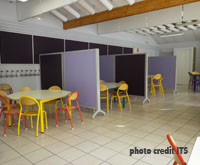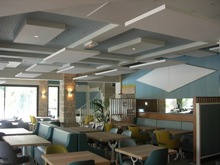Acoustic comfort in buildings covers a variety of issues as it relates both to the transmission of airborne noise (from the inside to the outside, or in the opposite direction or between different rooms of the same building), with the propagation of impact noises (solid noise), with the spatial sound propagation or with the reverberation of premises.
ITS can carry out engineering works in acoustics (measurements, calculations) and commercialize soundproofing products and constructive systems.
|
acoustic comfort in buildings |
ITS offers powerful solutions at a reasonable cost in response to all needs in terms of building acoustic insulation (construction or retrofit) by the means of equipment whose quality of design and of execution meets the highest requirement in this area in the context of compliance to the regulation or of improvement of acoustic comfort. Choice materials, robust constructions and quality finishes (allowing a good architectural integration) ensure high durability.
Professional building soundproofing
ITS markets soundproofing solutions for professional buildings, e.g. offices [1], meeting rooms [1], listening rooms for test jury.
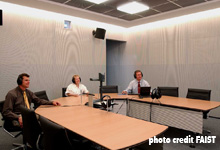
reverberation optimization in |
|
Sound insulation, reverberation control in public access buildings (PAB)
ITS offers, with or without their installation, products and linings for sound insulation, reverberation control in public access buildings (PAB) e.g. school buildings [2], healthcare facilities [2], hotels [2], sports halls [3], institutions hosting young children.
|
|
Namely for tertiary premises (wall linings for reverberation reduction: metallic or made of wood or made of mineral fiber or made of foam, acoustic suspended ceilings: metallic or made of wood or made of mineral fiber or made of foam, suspended baffles: made of mineral fiber or made of foam ...), also for industrial buildings |
Acoustic comfort of restaurants
ITS markets, with or without their implementation, components and systems for acoustic comfort in restaurants.
|
soundproofing barriers |
roof suspended absorbing |
For all types of dining rooms: canteens, refectories, cafeterias [2], company [1] or leisure restaurants, pubs ... |
- and also:
- building envelope elements: namely for industrial and tertiary buildings (acoustic door sets, ventilation silencers, acoustic walls and partitions, insulating floors, soundproofing roofs...)
- audiometric booths
- cabins for musicians, music rooms
- soundproofing systems for the noise reduction of domestic equipments (indoor or outdoor)
- vibration control systems
A wide range of technologies and services for acoustic comfort in buildings
ITS offers soundproofing products and equipment for buildings to improve the acoustic comfort and reduce reverberation.
Such means are an integral part of a program of technical measures to reduce sound transmissions, from the interior to the exterior of a building or room (then, in general, to limit the impact in terms of noise), or from the outside to the inside of a building or room (then, in general, to limit the sound pressure level with respect to neighbors or with respect to harware or facilities being inside or outside the edifice), and to create specific sound propagation conditions, within spaces located inside construction e.g. when it comes to promoting speaking or listening (human voice, music) in relation to the control of reverberation.
On-site measurements, design, construction (with or without installation) are part of the range of products and services marketed by ITS in terms of acoustic comfort in buildings.
[1] for reverberation times being always below the limits recommended in various refrence documents used in France e.g. standard NF S 31080 Acoustics - Offices and associated areas - Acoustic performances levels and criteria by type of area, standard NF S 31-199 Acoustics - Acoustical performances of open plan offices.
[2] for a reverberation time, and for noise reduction index always in compliance with regulatory values, i.e. in France, in accordance with the decrees of April 25, 2003 relating to noise limitation (in educational establishments, in health facilities, in hotels)
[3] for a reverberation time always less than the limits recommended by various reference documents, e.g. standard NF P 90-207 Acoustics - sports halls
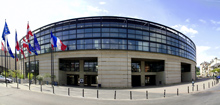
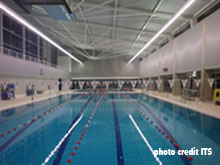 absorbing lining for walls in a sport facility (swimming pool)
absorbing lining for walls in a sport facility (swimming pool)